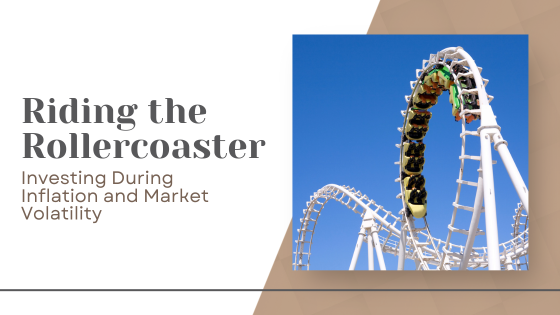
Riding the Rollercoaster: Investing During Inflation and Market Volatility
In today’s economic environment, where market volatility and inflation are often unpredictable and inevitable, investing can sometimes feel like a rollercoaster. However, investing during these periods doesn’t have to be a heart-stopping experience. Here are the key areas investors must be aware of to help their ride go more smoothly.
Understanding market volatility
In simple terms, market volatility represents the degree to which prices move in response to a set of returns and is measured by the standard deviation of those returns. As investors, we often perceive market volatility as a risk. However, it’s important to remember that volatility is common in equity markets but may present opportunities for higher returns.
The inflation factor
Inflation is an upward trend in the general level of prices for goods and services in an economy over a specific period. When experiencing inflation, one’s purchasing power erodes at the inflation rate. Therefore, investors technically lose money if investment returns are at least equal to the inflation rate. Hence, investing productively during inflation requires strategies to preserve and potentially enhance one’s purchasing power.
Diversification is key
One of the fundamental rules of investing during times of inflation and high market volatility is diversification. Holding a mix of different types of investments can help buffer against extreme market swings.
A portfolio diversified across various asset classes, such as equities, fixed income, commodities, and real estate, may better weather inflationary periods. Additionally, incorporating high-quality, short-term debt and inflation-protected securities may help during inflationary periods.
Focus on long-term investing
Another key strategy is to focus on long-term investing. Market volatility can create a lot of noise and prompt reactive behaviors that are not always in the investor’s best interest. Remembering that investing is a long-term process, not a short-term sprint, is beneficial.
Given the equity markets’ historical long-term upward trend, short-term declines have been merely temporary interruptions rather than permanent losses. Adopting a long-term perspective and resisting the urge to react impulsively to short-term market swings may be a more appropriate strategy.
Select resistant companies
It’s also worth noting that companies with pricing power—the ability to pass higher costs on to customers without reducing demand for their product—may provide a hedge against inflation. Such companies could include those in the technology, consumer staples, and healthcare sectors.
In periods of high inflation, these companies may outperform the broader market because they can maintain or even increase their profit margins despite rising costs.
Work with a financial professional
Finally, investors should consider working with a financial professional. While diversification and long-term investing are effective strategies, they require careful planning, research, and ongoing monitoring, which can be challenging for investors to manage independently. Financial professionals also offer specialized guidance to help investors navigate the complexities and challenges of investing during periods of inflation and market volatility.
The key to managing investments during rollercoaster periods is to be prepared, stay invested, and capitalize on the potential returns during these turbulent times.
Important Disclosures:
Investing involves risks including possible loss of principal. No investment strategy or risk management technique can guarantee return or eliminate risk in all market environments.
All information is believed to be from reliable sources; however, LPL Financial makes no representation as to its completeness or accuracy.
This article was prepared by Fresh Finance.
LPL Tracking #731836
Sources:
https://www.morningstar.com/markets/5-strategies-riding-market-roller-coaster
https://www.investopedia.com/terms/v/volatility.asp